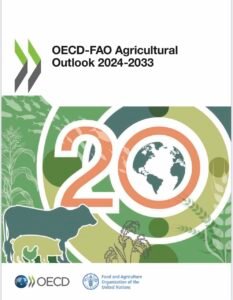OECD/FAO Agricultural Outlook 2024-2033

Prepared by: Prof. Salah Mahdi Hassan
Professor of Poultry Diseases / Poultry Health and Welfare Expert
6/8/2024
A comprehensive report, prepared by the Organization for Economic Co-operation and Development (OECD) in collaboration with the Food and Agriculture Organization (FAO), clarified the future of agricultural products by highlighting trends in consumption, production, trade and pricing over the next decade. The report pointed out several key trends and challenges facing the poultry industry during the forecast period from 2024 to 2033, as follows:
First: Production growth:
Global poultry production is expected to increase significantly, with a significant increase in developing countries due to local market needs. Global consumption of poultry meat is expected to reach 160 million metric tons equivalent to retail weight by 2033, which represents an increase of half of current production. The increase in poultry meat consumption is primarily due to several key regions and demographic trends. The largest growth in poultry consumption is expected to be in developing countries, especially in Asia. Countries such as China, India, Indonesia and Vietnam are leading the trend of increasing poultry production, due to rising incomes and urbanization, which boost demand for animal protein.
Second: Increased demand for animal protein:
There is a continuous increase in demand for animal protein, including poultry, which is considered the first priority due to its short production cycle and efficient feed conversion. There is particularly strong demand in the marketing complexes of developing countries.
Third: Disease challenges:
The poultry sector faces significant challenges from diseases such as highly virulent avian influenza, which can disrupt production and increase production costs.
Fourth: Environmental and health concerns:
The poultry industry is under great pressure to adapt to address environmental impacts, including greenhouse gas emissions and resource consumption. As is no secret, there are increasing consumer preferences for healthy food choices, which may shift demand away from traditional meat products.
Fifth: Economic pressures:
High production costs, including feed and labor, continue to pose a challenge to poultry producers. While feed prices have stabilized globally, the operating costs of other molecules remain high, affecting the expected profit rate.
Sixth: Technological progress:
Genetic improvements and advances in poultry breeding and management methods, as well as feed efficiency, are expected to boost productivity in the poultry sector, helping producers maintain their competitiveness despite higher production costs.
Finally, and in general, while the poultry industry is poised for growth and development, it must face major challenges related to disease containment, environmental sustainability, and changing consumer preferences.




